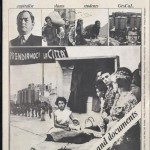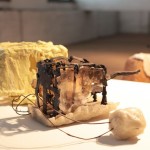Originated in 1920-1930s, the Factory-Kitchen(s) were early Soviet Union’s mechanized food preparation (from prefabrication to processing) service enterprises, associated with a characteristic architecture. The centralization of food preparation was not only destined to improve general consumption (supplying dining rooms or for personal purchase), but also to foster the emancipation of women from household work, in order for the female workforce to be employed elsewhere. (“Away with Pots and Pans!“).
As Bette Stavrakis wrote some years ago, “the Soviets have not really refuted the theory that woman’s place is in the home, but have expanded it into a new theory which holds that women’s place is in the factory as well as in the home.”
The double shift, as it operates today, has no theoretical justification in socialist theory, which always taught that housework and child care would be shared with the wife partly by communal services and partly by the husband. The ideas of Bebel, Engels, Kollontai, and Lenin on this matter were repeated in Soviet declarations right up to the mid-1930’s. The first post-revolutionary Party program hoped to abolish “the yoke of household economy by means of the House-Commune.” The ABC of Communism (1920) wondered how the woman toiler would “realize her rights when she has to look after the house, shop, stand in line, wash, tend to the child, and bear the heavy cross of housekeeping.” During the first Five Year Plan, laments and appeals rose to a crescendo. “Down with the kitchen!” exclaimed Ilin, the pedagogue of industrialization. “We shall destroy this little penitentiary! We shall free millions of women from house-keeping. They want to work like the rest of us. In a factory-kitchen, one person can prepare from fifty to one hundred dinners a day. We shall force machines to peel potatoes, wash the dishes, cut the bread, stir the soup, make ice cream.” And slogans like “The Saucepan is the Enemy of the Party Cell” or “Away with Pots and Pans” became watchwords of economic and political agitation.
Richard Stites, The Women’s Liberation Movement in Russia: Feminism, Nihilism, and Bolshevism, 1860-1930, 1978, p. 409
Following is Alexander Rodchenko‘s (1891–1956) photographic documentation of such an enterprise.

















Images via Ross Wolfe and Nigel Fowler Sutton





[…] de Samara, disputas acerca de su nuevo uso: Centro de Arte Contemporáneo o Centro Comercial Acerca de las Cocinas Industriales: Factory-Kitchens Artículo “The hammer-and-sickle kitchen-factory in Samara (1931)” publicado en The […]